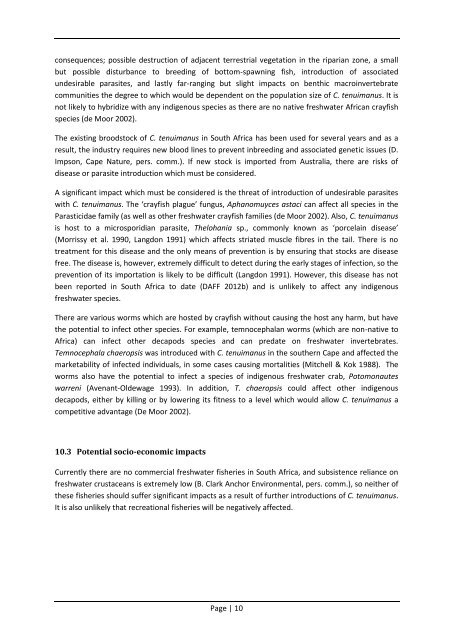Marron, freshwater crayfish Cherax tenuimanus - Department of ...
Marron, freshwater crayfish Cherax tenuimanus - Department of ...
Marron, freshwater crayfish Cherax tenuimanus - Department of ...
Create successful ePaper yourself
Turn your PDF publications into a flip-book with our unique Google optimized e-Paper software.
consequences; possible destruction <strong>of</strong> adjacent terrestrial vegetation in the riparian zone, a small<br />
but possible disturbance to breeding <strong>of</strong> bottom-spawning fish, introduction <strong>of</strong> associated<br />
undesirable parasites, and lastly far-ranging but slight impacts on benthic macroinvertebrate<br />
communities the degree to which would be dependent on the population size <strong>of</strong> C. <strong>tenuimanus</strong>. It is<br />
not likely to hybridize with any indigenous species as there are no native <strong>freshwater</strong> African <strong>crayfish</strong><br />
species (de Moor 2002).<br />
The existing broodstock <strong>of</strong> C. <strong>tenuimanus</strong> in South Africa has been used for several years and as a<br />
result, the industry requires new blood lines to prevent inbreeding and associated genetic issues (D.<br />
Impson, Cape Nature, pers. comm.). If new stock is imported from Australia, there are risks <strong>of</strong><br />
disease or parasite introduction which must be considered.<br />
A significant impact which must be considered is the threat <strong>of</strong> introduction <strong>of</strong> undesirable parasites<br />
with C. <strong>tenuimanus</strong>. The ‘<strong>crayfish</strong> plague’ fungus, Aphanomuyces astaci can affect all species in the<br />
Parasticidae family (as well as other <strong>freshwater</strong> <strong>crayfish</strong> families (de Moor 2002). Also, C. <strong>tenuimanus</strong><br />
is host to a microsporidian parasite, Thelohania sp., commonly known as ‘porcelain disease’<br />
(Morrissy et al. 1990, Langdon 1991) which affects striated muscle fibres in the tail. There is no<br />
treatment for this disease and the only means <strong>of</strong> prevention is by ensuring that stocks are disease<br />
free. The disease is, however, extremely difficult to detect during the early stages <strong>of</strong> infection, so the<br />
prevention <strong>of</strong> its importation is likely to be difficult (Langdon 1991). However, this disease has not<br />
been reported in South Africa to date (DAFF 2012b) and is unlikely to affect any indigenous<br />
<strong>freshwater</strong> species.<br />
There are various worms which are hosted by <strong>crayfish</strong> without causing the host any harm, but have<br />
the potential to infect other species. For example, temnocephalan worms (which are non-native to<br />
Africa) can infect other decapods species and can predate on <strong>freshwater</strong> invertebrates.<br />
Temnocephala chaeropsis was introduced with C. <strong>tenuimanus</strong> in the southern Cape and affected the<br />
marketability <strong>of</strong> infected individuals, in some cases causing mortalities (Mitchell & Kok 1988). The<br />
worms also have the potential to infect a species <strong>of</strong> indigenous <strong>freshwater</strong> crab, Potomonautes<br />
warreni (Avenant-Oldewage 1993). In addition, T. chaeropsis could affect other indigenous<br />
decapods, either by killing or by lowering its fitness to a level which would allow C. <strong>tenuimanus</strong> a<br />
competitive advantage (De Moor 2002).<br />
10.3 Potential socio-economic impacts<br />
Currently there are no commercial <strong>freshwater</strong> fisheries in South Africa, and subsistence reliance on<br />
<strong>freshwater</strong> crustaceans is extremely low (B. Clark Anchor Environmental, pers. comm.), so neither <strong>of</strong><br />
these fisheries should suffer significant impacts as a result <strong>of</strong> further introductions <strong>of</strong> C. <strong>tenuimanus</strong>.<br />
It is also unlikely that recreational fisheries will be negatively affected.<br />
Page | 10
















